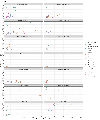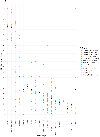Review of the Breathability and Filtration Efficiency of Common Household Materials for Face Masks
- PMID: 33822580
- PMCID: PMC8900768
- DOI: 10.1021/acsnano.0c10146
Review of the Breathability and Filtration Efficiency of Common Household Materials for Face Masks
Abstract
The World Health Organization and the United States Centers for Disease Control have recommended universal face masking by the general public to slow the spread of COVID-19. A number of recent studies have evaluated the filtration efficiency and pressure differential (an indicator of breathability) of various, widely available materials that the general public can use to make face masks at home. In this review, we summarize those studies to provide guidance for both the public to select the best materials for face masks and for future researchers to rigorously evaluate and report on mask material testing. Of the tested fabric materials and material combinations with adequate breathability, most single and multilayer combinations had a filtration efficiency of <30%. Most studies evaluating commonly available mask materials did not follow standard methods that would facilitate comparison across studies, and materials were often described with too few details to allow consumers to purchase equivalent materials to make their own masks. To improve the usability of future study results, researchers should use standard methods and report material characteristics in detail.
Keywords: COVID-19; SARS-CoV-2; breathability; cloth mask; face mask; filtration efficiency; homemade mask; pressure differential.
Figures







References
-
- CDC. Your Guide to Masks https://www.cdc.gov/coronavirus/2019-ncov/prevent-getting-sick/about-fac... (accessed Feb 23, 2021).
-
- Chu DK; Akl EA; Duda S; Solo K; Yaacoub S; Schünemann HJ; COVID-19 Systematic Urgent Review Group Effort (SURGE) Study Authors. Physical Distancing, Face Masks, and Eye Protection to Prevent Person-to-Person Transmission of SARS-CoV-2 and COVID-19: A Systematic Review and Meta-Analysis. Lancet 2020, 395 (10242), 1973–1987. - PMC - PubMed
-
- National Academies of Sciences, Engineering, and Medicine. Rapid Expert Consultation on the Effectiveness of Fabric Masks for the COVID-19 Pandemic (April 8, 2020); The National Academies Press: Washington, DC, 2020.
Publication types
MeSH terms
Grants and funding
LinkOut - more resources
Full Text Sources
Other Literature Sources
Medical
Miscellaneous

